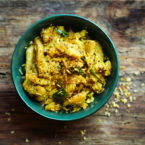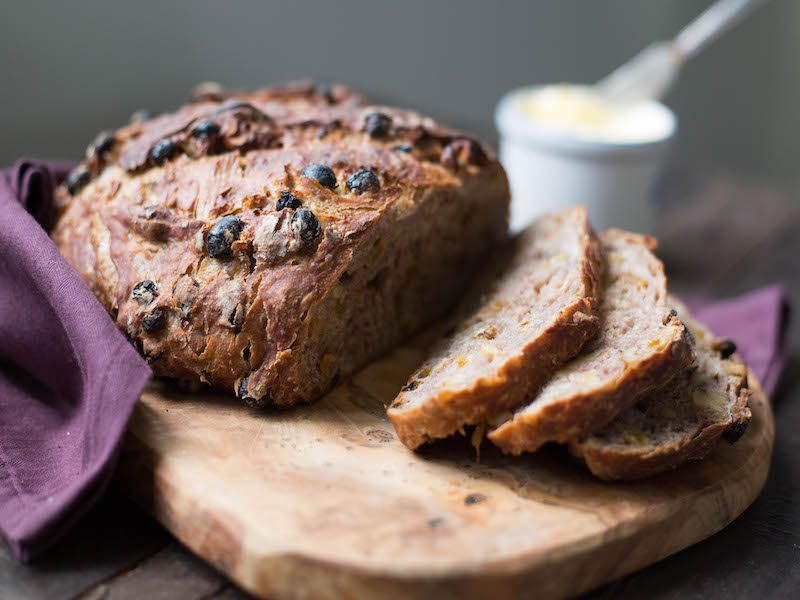An integral part of Kerala cuisine, Thoran, is a lovely stir-fry made with grated coconut and minimal spices. Try it with plantain, served with rice as a delicious main course.
Thoran, a quintessential component of Kerala cuisine, is a vibrant and aromatic stir-fry featuring finely chopped vegetables, coconut, and a variety of spices.
From potatoes to cabbage, carrots, green beans, broccoli or even pumpkin, you can make a Thoran with almost any vegetable that can hold some shape after cooking.
Today’s version is made with my favorite vegetable – plantain or (green) raw banana. This is my go-to recipe whenever I am out of ideas; super tired or when I hardly have any fresh vegetables on hand.
All of the ingredients needed for this recipe should be available in your local Asian or Indian food store, but just in case you have a hard time finding something, here’s a rundown of the ingredients, what they do – and how they can be replaced:
-
Green Plantains:
- Description: Green plantains are starchy and less sweet compared to ripe plantains. They are used similarly to potatoes in various cuisines.
- Alternative: If green plantains are unavailable, you can use green bananas or even potatoes as a substitute, although the texture and flavor will slightly differ.
-
Urad Dal (Split White Urad Dal):
- Description: Urad dal, also known as black gram, is a small, skinned, and split white lentil used frequently in Indian cuisine for tempering dishes.
- Alternative: If you can’t find urad dal, you can omit it or use chana dal (split chickpeas) for a similar textural purpose in the dish.
-
Mustard Seeds:
- Description: Mustard seeds are a common tempering spice in Indian cooking, adding a nutty and aromatic flavor when popped in hot oil.
- Alternative: A suitable substitute for mustard seeds can be cumin seeds or a pinch of dry mustard powder to mimic the tangy, peppery flavor.
-
Asafoetida (Hing):
- Description: Asafoetida is a resinous gum derived from ferula plants, known for its strong onion-garlic flavor, used primarily as a digestive aid and to add depth in flavor.
- Alternative: If unavailable, you can use a small pinch of garlic powder and onion powder as a replacement.
-
Curry Leaves:
- Description: Curry leaves are aromatic herbs used in South Indian cooking, providing a unique flavor that is irreplaceable.
- Alternative: While there’s no perfect substitute, you can use bay leaves or lemon zest to add a different dimension of flavor, though it won’t replicate the original taste entirely.
-
Cumin Seeds:
- Description: Cumin seeds are used in Indian cuisine for their distinctive earthy and warming flavor when added to hot oil.
- Alternative: If cumin seeds are not available, you can use ground cumin, but add it directly to the dish instead of in the oil to prevent burning.
-
Turmeric Powder:
- Description: Turmeric is a bright yellow spice, commonly used in Indian dishes for its color and health benefits, offering a warm, bitter taste.
- Alternative: Although unique, a mix of ginger and mustard powder can be used in a pinch to try and mimic some of turmeric’s flavor profile.
-
Coconut, Grated:
- Description: Freshly grated coconut is often used in South Indian cooking for its sweetness and texture.
- Alternative: Unsweetened desiccated coconut or canned coconut milk can be used if fresh coconut is not available.
Recipe Notes
- Ensure to soak the plantains if they are very starchy, which helps in removing some of the starch and prevents them from becoming too hard when cooked.
- The key to a good thoran is the tempering; make sure your oil is hot enough before adding the mustard seeds to ensure they pop and release their flavor.
- Be gentle when mixing the grated coconut into the cooked plantains to maintain the texture of the dish.
- Adjust the amount of green chilies based on your heat preference. The dish should have a balance of spicy, salty, and the natural sweetness from the coconut.

How to Make Plantain and Coconut Thoran
-
Prep the Plantains:
- Cut the plantains into halves with the skin on.
- Boil in water until tender—about 10-15 minutes; or pressure cook for one whistle and let the pressure release naturally.
- Once cooled, peel and dice the plantains into small cubes.
-
Tempering the Spices:
- In a large skillet, heat the oil over medium heat.
- Add the mustard seeds, urad dal, and cumin seeds. Wait until the mustard seeds start to pop and the dal turns golden.
- Add the dry red chili, curry leaves, and a pinch of asafoetida. Stir for a few seconds until aromatic.
-
Cook the Onions and Spices:
- Add the chopped onions and a pinch of salt to help them cook faster. Sauté until they turn translucent.
- Mix in the ginger-garlic paste and green chilies, cooking for an additional 2 minutes.
-
Combine and Cook the Plantain:
- Stir in the turmeric powder and salt.
- Add the diced plantains to the skillet and toss gently to mix with the spices.
- Cook on a low-medium flame for about 4 minutes, allowing the flavors to meld.
-
Finish with Coconut:
- Add the grated coconut and stir well.
- Continue to cook for another 5 minutes, then remove from heat.
To Serve:
- Serve the Plantain Thoran hot alongside rice or roti.

Kerala Stir Fry: Plantain and Coconut Thoran
- Total Time: 45 minutes
- Yield: 4 servings 1x
Description
An integral part of Kerala cuisine, Thoran, is a lovely stir-fry made with grated coconut and minimal spices. Try it with plantain, served with rice as a delicious main course.
Ingredients
- 2 green plantains
- 1 large onion, finely chopped
- 1–2 green chilies, finely chopped
- 1 teaspoon ginger-garlic paste
- 1/2 cup grated coconut
- 1/4 teaspoon turmeric powder
- Salt to taste
For Tempering
- 1/4 teaspoon mustard seeds
- 1/4 teaspoon split white urad dal
- 1/2 teaspoon cumin seeds
- 1 dry red chili, broken into halves
- A pinch of asafoetida (hing)
- A few curry leaves
- 2 teaspoons vegetable oil
Instructions
- Prep the Plantains:
- Cut the plantains into halves with the skin on.
- Boil in water until tender—about 10-15 minutes; or pressure cook for one whistle and let the pressure release naturally.
- Once cooled, peel and dice the plantains into small cubes.
- Tempering the Spices:
- In a large skillet, heat the oil over medium heat.
- Add the mustard seeds, urad dal, and cumin seeds. Wait until the mustard seeds start to pop and the dal turns golden.
- Add the dry red chili, curry leaves, and a pinch of asafoetida. Stir for a few seconds until aromatic.
- Cook the Onions and Spices:
- Add the chopped onions and a pinch of salt to help them cook faster. Sauté until they turn translucent.
- Mix in the ginger-garlic paste and green chilies, cooking for an additional 2 minutes.
- Combine and Cook the Plantain:
- Stir in the turmeric powder and salt.
- Add the diced plantains to the skillet and toss gently to mix with the spices.
- Cook on a low-medium flame for about 4 minutes, allowing the flavors to meld.
- Finish with Coconut:
- Add the grated coconut and stir well.
- Continue to cook for another 5 minutes, then remove from heat.
Notes
- Green Plantains:
- Description: Green plantains are starchy and less sweet compared to ripe plantains. They are used similarly to potatoes in various cuisines.
- Alternative: If green plantains are unavailable, you can use green bananas or even potatoes as a substitute, although the texture and flavor will slightly differ.
- Urad Dal (Split White Urad Dal):
- Description: Urad dal, also known as black gram, is a small, skinned, and split white lentil used frequently in Indian cuisine for tempering dishes.
- Alternative: If you can’t find urad dal, you can omit it or use chana dal (split chickpeas) for a similar textural purpose in the dish.
- Mustard Seeds:
- Description: Mustard seeds are a common tempering spice in Indian cooking, adding a nutty and aromatic flavor when popped in hot oil.
- Alternative: A suitable substitute for mustard seeds can be cumin seeds or a pinch of dry mustard powder to mimic the tangy, peppery flavor.
- Asafoetida (Hing):
- Description: Asafoetida is a resinous gum derived from ferula plants, known for its strong onion-garlic flavor, used primarily as a digestive aid and to add depth in flavor.
- Alternative: If unavailable, you can use a small pinch of garlic powder and onion powder as a replacement.
- Curry Leaves:
- Description: Curry leaves are aromatic herbs used in South Indian cooking, providing a unique flavor that is irreplaceable.
- Alternative: While there’s no perfect substitute, you can use bay leaves or lemon zest to add a different dimension of flavor, though it won’t replicate the original taste entirely.
- Cumin Seeds:
- Description: Cumin seeds are used in Indian cuisine for their distinctive earthy and warming flavor when added to hot oil.
- Alternative: If cumin seeds are not available, you can use ground cumin, but add it directly to the dish instead of in the oil to prevent burning.
- Turmeric Powder:
- Description: Turmeric is a bright yellow spice, commonly used in Indian dishes for its color and health benefits, offering a warm, bitter taste.
- Alternative: Although unique, a mix of ginger and mustard powder can be used in a pinch to try and mimic some of turmeric’s flavor profile.
- Coconut, Grated:
- Description: Freshly grated coconut is often used in South Indian cooking for its sweetness and texture.
- Alternative: Unsweetened desiccated coconut or canned coconut milk can be used if fresh coconut is not available.
Recipe Notes
- Ensure to soak the plantains if they are very starchy, which helps in removing some of the starch and prevents them from becoming too hard when cooked.
- The key to a good thoran is the tempering; make sure your oil is hot enough before adding the mustard seeds to ensure they pop and release their flavor.
- Be gentle when mixing the grated coconut into the cooked plantains to maintain the texture of the dish.
- Adjust the amount of green chilies based on your heat preference. The dish should have a balance of spicy, salty, and the natural sweetness from the coconut.
- Prep Time: 15 mins
- Cook Time: 30 mins
- Category: Main
- Method: Stir Frying
- Cuisine: Indian





















Absolutely loved this recipe! It was my first time using turmeric and the dish turned out beautifully colorful and flavorful. I paired it with jasmine rice and the meal was a hit!
I had a hard time finding curry leaves but went ahead without. The dish still tasted great, but I’m curious about the authentic flavor!
Loved learning about the sustainability aspect of Thoran. I used locally sourced plantains and organic coconut from a nearby market. It’s great to cook a meal that feels good for the planet too!
This was my first attempt at a Kerala dish, and I’m so proud of how it turned out. The mustard seeds popping was my favorite part! Added extra chilies because we love our food spicy. Will make again!
Used green bananas instead of plantains because that’s what I had on hand, and the dish was still superb. The grated coconut really ties all the flavors together. This one’s saved to my favorites.
I appreciate the background info on Thoran. I’ve started using more coconut in my cooking thanks to this recipe, and I love how it brings out the freshness of the ingredients. Perfect with roti
Made this for my family last night and it was a success! Even the kids enjoyed the mild spices and the sweetness of the plantains. Thanks for a simple and effective recipe!